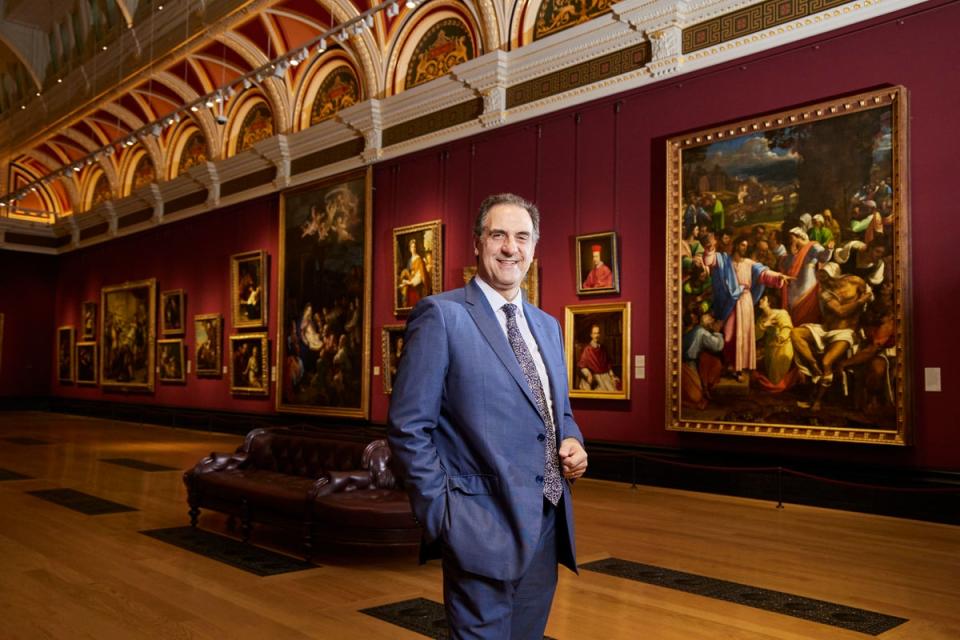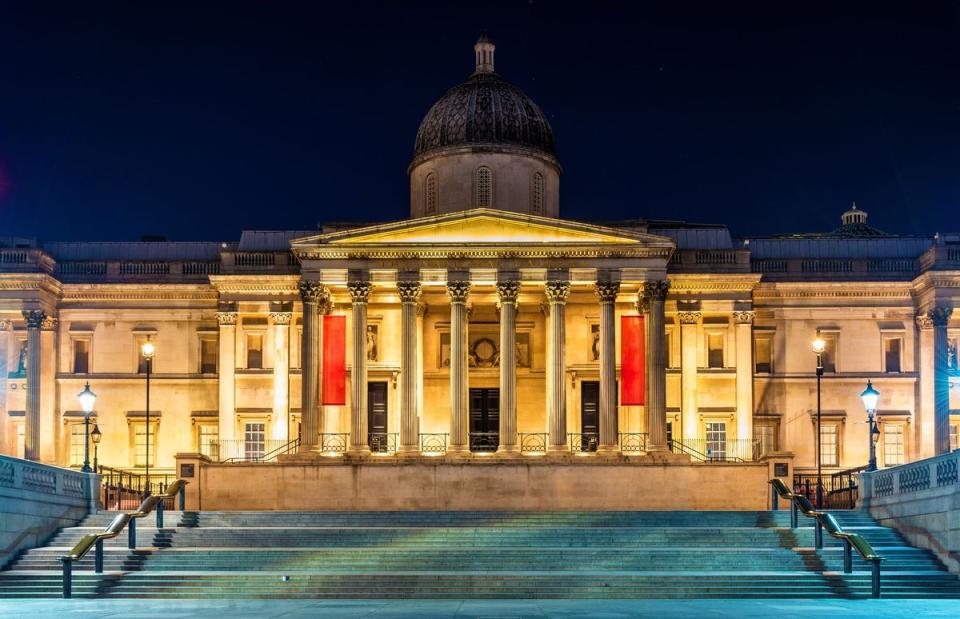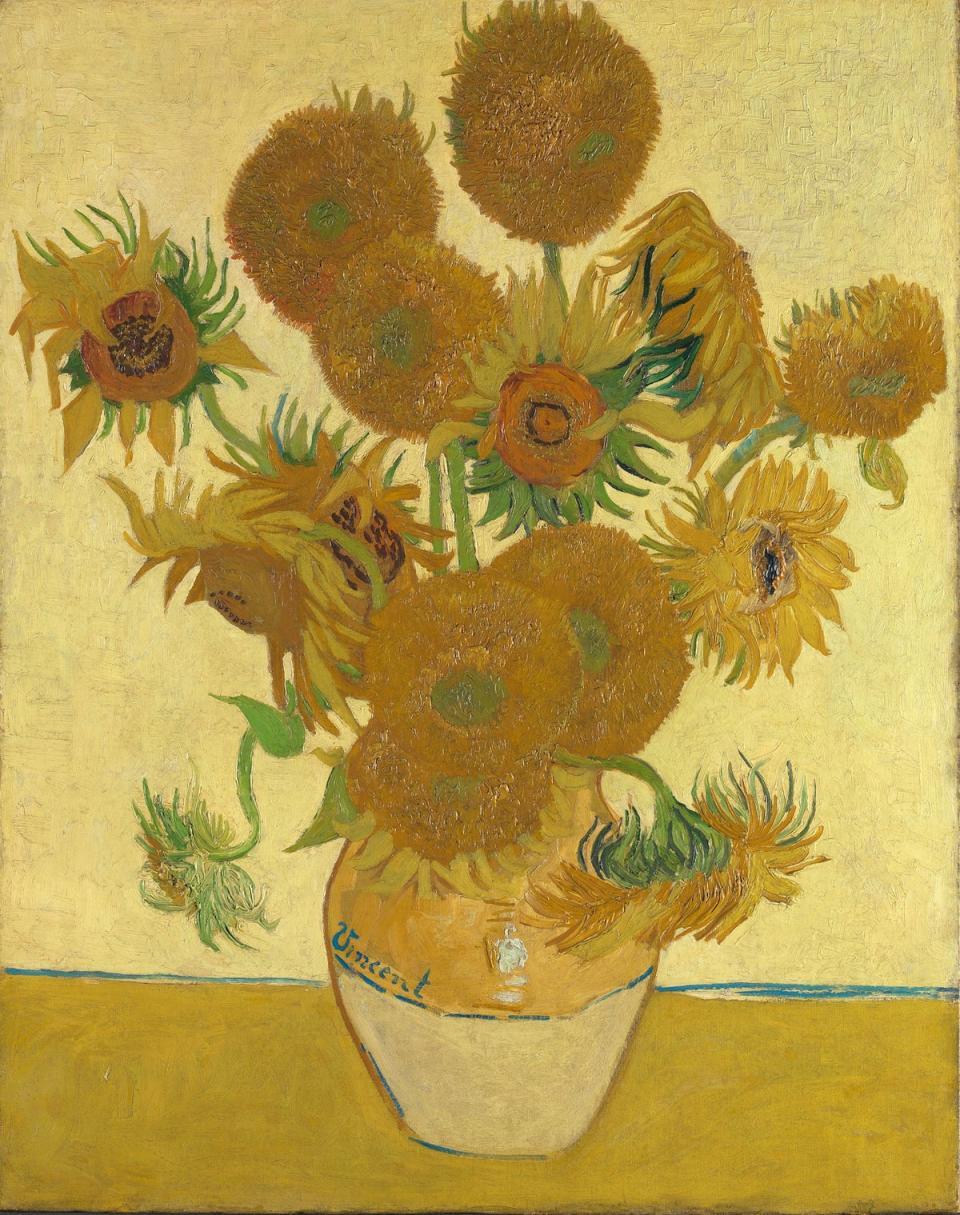It’s very rare that you get the chance to celebrate the 200th birthday of a valuable institution. But today, champagne corks will pop in the heart of London as the National Gallery, one of Britain’s greatest cultural jewels, enters that venerable era.
Tonight, from 21.00, the Big Weekend celebrations will be held, starting with a spectacular lighting display projected onto the façade of the famous neo-classical building in Trafalgar Square. There will also be concerts, workshops, talks and tours led by Jools Holland, as well as stories from the gallery’s storied past.
Gabriele Finaldi is the director of the National Gallery, who saw it in the 200s. “It is a great privilege to be part of the generation that has crossed the threshold of the third century,” he says. “It’s not like any other year; The bicentennial galvanized people’s love for and generosity towards the gallery.” He adds with a laugh: “If we could, we would extend the birthday celebrations to 200 years.”
Over the past two centuries, more than 300 million people have come to see some of the most recognizable paintings in art history. Today, they come from all over the world to enjoy the works of masters, from Leonardo to Turner, from Raphael to Van Gogh, from Constable to Botticelli.
It may have global appeal, but its importance to London and its residents is intrinsic. Finaldi, 59, says: “For Londoners, most of us grew up with the National Gallery; “We felt it was ours and it became part of our lives… It is embedded in the history of this country and London.”

And it’s not just the National Gallery, he adds. “London attracts people; Its cultural biosphere is unique. Speaking of collections alone – not to mention theatre, music and other things – there is a wealth of world culture here for nearly two centuries of professionals to share with the public. “It’s not the same in Paris, Rome or Madrid.”
Finaldi says the gallery is in good health, but “the bicentennial gives us the opportunity to become an even better museum.” This includes major construction works, along with a privately funded £85 million refurbishment of the Sainsbury Wing, which will open next spring to mark the end of the bicentenary celebrations.
Everyone has their favorite works. In the film, which was released to coincide with his 200th birthday, Sir Michael Palin chose a work by Turner, Claudia Winkleman chose Leonardo’s The Virgin of the Rocks, and Princess Eugenie chose Correggio’s Madonna of the Basket.
Today, Vincent van Gogh’s Sunflowers is the most popular work in the gallery and sells the most items in the store, according to Finaldi, a relatively new development. When he started working as a curator at the National Gallery in 1992, JMW Turner’s The Fighting Temeraire and Leonardo da Vinci’s The Virgin of the Rocks were the biggest draws.
The gallery is also busy overhauling its research and education centers and building a network of partners across the country.
“We inherited this from previous generations and it is our duty to deliver the gallery in a better condition than we found it,” says Finaldi. “With new acquisitions, new understanding of what the gallery is about… and if we’ve done that, we’ve done a lot.”
Although the museum did not reach its peak of more than six million visitors a year before the pandemic, it increased by 14 percent to more than three million last year. “In a way, it’s good that we don’t have those numbers right now because a third of our property is closed. I mean, look at the gallery,” says Finaldi.
We are driving around on a Thursday afternoon and the weather is very severe. It’s full of tourists, locals, day trippers, families and kids on school trips.
The gallery’s roots date back to 1824, when the government purchased the works of London businessman John Julius Angerstein under pressure from art activists who wanted Britain to establish a national collection.
The first 38 photographs were exhibited in Angerstein’s home at 100 Pall Mall, but as the collection grew, a new, larger location was needed and the gallery moved to its current location in 1838.


It was thought that all classes in the community would benefit from the area and with the promise of free admission. “Many countries were doing this,” says Finaldi, “and it was felt that, as the capital of an empire, it needed an outstanding art institution that would beautify the city. But it was also a place of education where British society could coexist peacefully.”
The gallery expanded over the years, adding new wings and rooms; the last being the Sainsbury Wing, which opened in 1991. It also suffered bomb damage during the Blitz. The total floor area is currently equivalent to approximately six football fields. The National Gallery’s remit covers European painting from the Middle Ages to the beginning of the 20th century (the most recent painting dates from the 20s).
But as the curator of a collection of historical artifacts, Finaldi is aware that he must ensure that this place is a living museum, not a mausoleum.
“Although, in a sense, the roots of these works date back to a moment in history, we, as a society, find them important, so we keep them up to date. “They continue to be talked about, studied, copied and inspire contemporary artists.” It’s clear that the interest hasn’t waned yet, not only from the crowd, but also from the glitzy summer party she’s started to throw: last year she attracted the attention of Maya Jama, Grayson Perry and Bella Freud, but this year she’s off the ice, replaced by birthday celebrations.
When it fully reopens, the gallery will reorganize its collection, just as Tate Britain did in 2023, giving it the chance to tell different stories and highlight different painters. Finaldi says that because of the lack of diversity in the collection, more research is being done to rethink the stories the gallery tells, especially about underrepresented groups.
Another part of the director’s job in 2024 is preserving the collection, after protesters attacked works such as The Hay Wain, Sunflowers and Rokeby Venus. Keeping them safe is a big challenge, he says. “When you hear that a photo has been hacked, it’s always shocking news,” Finaldi recently told the BBC. “I’m angry at the protesters because they’re damaging something that’s precious to all of us.”
Another challenge relates to the threat of reduced education and school trips. He hopes the culture will become more ingrained in the school curriculum. “Maths, sciences and literacy are very important, but we need the nourishment of history, beauty and music to be fully human. Museums are places where all this can happen.
“It’s not just about art history, it’s about understanding how society works and how people in history have dealt with the things we deal with now – whether it’s death, love, family or faith. So much is represented in our work, and it’s up to us to find ways to bring it all to life.”


And even classical artists move in and out of fashion. Caravaggio is now a blockbuster painting, but that’s only changed in the last 70 years, and of course there’s Van Gogh, who never sold any of his works in his lifetime. “In the last 30 years, Van Gogh has turned into a bulldozer that dominates everything, and Sunflowers have turned into a talismanic painting for us. He wanted to paint something joyful, uplifting, and symbolic of friendship. “He continues to do so more than a century later.”
The National Gallery has about 2,400 paintings in its collection, and the gallery will be able to display around 1,000 of them when it reopens next spring. “It’s a small collection; I worked at the Prado, there are 8,000 of them, the Louvre has that kind of number and the Tate has more than us. You can never display more than half the collection. “On the one hand, we have a very small collection, but a large part of our collection is on display.”
Finaldi wanders the corridors of the gallery every day, something he learned from former National Galley and British Museum director Neil MacGregor.
“He said it was the best way to stay informed about what was going on in the gallery, to understand how the public was responding to the collection. Allowing room attendants to tell you things if they need and also boosting your morale at the end of the day. You realize that’s what it’s all about.”
He’s clearly still excited about it all. “The National Gallery is like a treasure chest full of beautiful jewels; When you open it, it becomes much larger than you first thought. “Every painting is a discovery if you give it some time.”
nationalgallery.org.uk